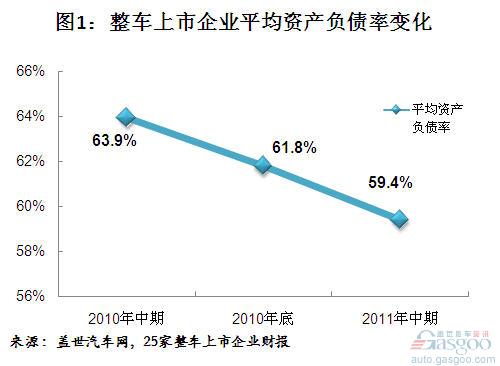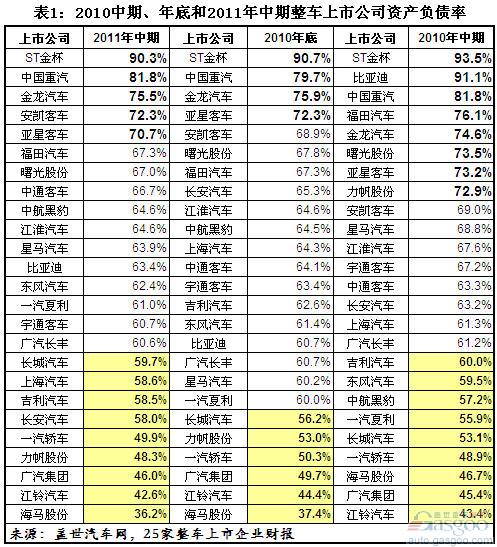The average asset-liability ratio of China's entire vehicle listed companies is reduced According to the financial report data of completed vehicles listed by Gasgoo.com, the average debt-to-liability ratio of 25 listed companies in China in mid-2011 was 59.4%, compared with the mid-term and end of 2010 (63.9% and 61.8%) have declined. However, the asset-liability ratio of 16 of the 25 companies is more than 60%, and only 9 companies have asset-liability ratios below 60% (see Table 1).
Asset-liability ratio higher than 70%
In mid-2011, there were five vehicle listed companies with asset-liability ratios above 70%, namely the ST Gold Cup, China National Heavy Duty Truck, Jinlong Automobile, Ankai Bus and Yaxing Bus. Among them, the ST Gold Cup had the highest debt-to-asset ratio in the middle of 2010, the end of the year, and the middle of 2011. It was 90.3% in the middle of the year, but it fell from the end of last year and the middle period (90.7%, 93.5%). The second-highest asset-liability ratio in the medium-term is China National Heavy Duty Truck, which has an asset-liability ratio of 81.8%.
Compared with the mid-2010 and the end of 2010, the company's asset-liability ratio rose from 60% to 70% to more than 70% of the company's Ankai bus, and its asset-liability ratio this year was 72.3%.
The asset-liability ratio is between 60% and 70%. There are 11 vehicle-listed companies with asset-liability ratios ranging from 60% to 70% in mid-2011. They are: Foton Motor, Shuguang, Zhongtong Bus, CNAC Panthers, JAC. Automobiles, Xingma Automobile, BYD, Dongfeng Motor, FAW Xiali, Yutong Bus and GAC Changfeng.
Compared with the mid-2010 period, the asset-liability ratio fell from more than 70% to 60% to 70% in the range of Foton Motor, Shuguang and BYD. Among them, BYD fell the most, from 91.1% in the middle of 2010 to 63.4%; Foton Motor and Shuguang shares fell to 67.3% and 67.0%, respectively.
Compared with the same period of last year, the asset-liability ratios of the Air China Panthers, Dongfeng Motor, and FAW Xiali, which have risen from below 60% to 60% to 70%, were 64.6%, 62.4%, and 61.0% respectively.
Asset-liability ratio below 60%
In mid-2011, the asset-liability ratio was less than 60%. There are nine vehicle listed companies, namely Great Wall Motors, Shanghai Automotive, Geely Automobile, Changan Automobile, FAW Car, Lifan, GAC, Jiangling Motors and Haima. Among them, the lowest asset-liability ratio of Haima's shares was only 36.2%.
Compared with the end of 2010, the asset-liability ratio fell from 60% to 70% range to 60% below the range of Shanghai Automotive, Geely Automobile and Changan Automobile, its asset-liability ratio dropped to 58.6%, 58.5% and 58.0% .
Compared with the mid-2010 period, Lifan shares, which had a debt-to-asset ratio of more than 70% and below 60%, had a debt-to-asset ratio falling from 72.9% to 48.3% in the middle of the year.
Note:
Asset-liability ratio refers to the ratio of the total liabilities of the company at the end of the year to the total assets. It shows how much of the company’s total assets are raised through liabilities. This indicator is a comprehensive indicator of the company’s debt level. At the same time, it is also an indicator to measure the ability of a company to use creditor funds to conduct business activities, and it also reflects the degree of security for creditors to issue loans.
As a measure of the level of corporate debt, asset-liability ratio should be more appropriate within a certain range. This may have different answers in different industries, but it is generally considered that it is appropriate to be around 60%. The asset-liability ratio of the auto vehicle industry can be referred to herein.


Asset-liability ratio higher than 70%
In mid-2011, there were five vehicle listed companies with asset-liability ratios above 70%, namely the ST Gold Cup, China National Heavy Duty Truck, Jinlong Automobile, Ankai Bus and Yaxing Bus. Among them, the ST Gold Cup had the highest debt-to-asset ratio in the middle of 2010, the end of the year, and the middle of 2011. It was 90.3% in the middle of the year, but it fell from the end of last year and the middle period (90.7%, 93.5%). The second-highest asset-liability ratio in the medium-term is China National Heavy Duty Truck, which has an asset-liability ratio of 81.8%.
Compared with the mid-2010 and the end of 2010, the company's asset-liability ratio rose from 60% to 70% to more than 70% of the company's Ankai bus, and its asset-liability ratio this year was 72.3%.

The asset-liability ratio is between 60% and 70%. There are 11 vehicle-listed companies with asset-liability ratios ranging from 60% to 70% in mid-2011. They are: Foton Motor, Shuguang, Zhongtong Bus, CNAC Panthers, JAC. Automobiles, Xingma Automobile, BYD, Dongfeng Motor, FAW Xiali, Yutong Bus and GAC Changfeng.
Compared with the mid-2010 period, the asset-liability ratio fell from more than 70% to 60% to 70% in the range of Foton Motor, Shuguang and BYD. Among them, BYD fell the most, from 91.1% in the middle of 2010 to 63.4%; Foton Motor and Shuguang shares fell to 67.3% and 67.0%, respectively.
Compared with the same period of last year, the asset-liability ratios of the Air China Panthers, Dongfeng Motor, and FAW Xiali, which have risen from below 60% to 60% to 70%, were 64.6%, 62.4%, and 61.0% respectively.
Asset-liability ratio below 60%
In mid-2011, the asset-liability ratio was less than 60%. There are nine vehicle listed companies, namely Great Wall Motors, Shanghai Automotive, Geely Automobile, Changan Automobile, FAW Car, Lifan, GAC, Jiangling Motors and Haima. Among them, the lowest asset-liability ratio of Haima's shares was only 36.2%.
Compared with the end of 2010, the asset-liability ratio fell from 60% to 70% range to 60% below the range of Shanghai Automotive, Geely Automobile and Changan Automobile, its asset-liability ratio dropped to 58.6%, 58.5% and 58.0% .
Compared with the mid-2010 period, Lifan shares, which had a debt-to-asset ratio of more than 70% and below 60%, had a debt-to-asset ratio falling from 72.9% to 48.3% in the middle of the year.
Note:
Asset-liability ratio refers to the ratio of the total liabilities of the company at the end of the year to the total assets. It shows how much of the company’s total assets are raised through liabilities. This indicator is a comprehensive indicator of the company’s debt level. At the same time, it is also an indicator to measure the ability of a company to use creditor funds to conduct business activities, and it also reflects the degree of security for creditors to issue loans.
As a measure of the level of corporate debt, asset-liability ratio should be more appropriate within a certain range. This may have different answers in different industries, but it is generally considered that it is appropriate to be around 60%. The asset-liability ratio of the auto vehicle industry can be referred to herein.
Medical Device Blister,Tyvek Hot-Press Blister Box,Tyvek Blister Tray For Medical Device,Pvc Ablation Electrode Mask Blister
Dong Guan Yi He Medical Packaging Technology Co.,Ltd , https://www.yhmedicalpack.com